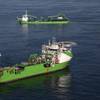The Siemens Industrial Solutions and Services Group (I&S) has developed the "Siship Coges" hybrid power-supply and propulsion system for use on LNG (liquefied natural gas) tankers. Two SGT 500 gas turbines are the heart of the electrical power generation system.
This type of turbine is designed to be operated with gaseous and liquid fuels at the same time, as a result of which the "boil-off" of the LNG can be used as well as heavy-oil and diesel fuels. Two heat-recovery units, a steam turbine, and an optional diesel generator complete the on-board power system. The approximately 50,000 kW of generated electrical energy supplies two electric motors for powering the propeller shafts, the liquid-gas compressors, and pumps in the cargo area; as well as the on-board power supply system. The hybrid system is characterized by its low maintenance and space requirements, and its high availability.
Compared to other cargo ships, LNG tankers have an unusual feature in that the pressure-less gas, which is cooled to -163 °C, evaporates at a typical rate of 0.15 percent per day. This so-called "boil-off" has to be returned to the tanks by means of compressors and pumps.
Siemens is now offering an alternative, whereby the boil-off is also used to generate electrical energy and propel the ship. The main feature of the hybrid solution is its two SGT 500 gas turbines. The turbines are capable of using gaseous and liquid fuels such as heavy oil and marine diesel – simultaneously, and their useful life is around three times longer than other types of turbines. Each turbine has an output of 17,000 kW at 360 rpm. Another 10,000 kW of power is obtained from the waste gases, which are just under 380 °C. This is done by means of two heat-recovery units and one steam turbine. As an option, a diesel generator, which typically provides another 5000 kilowatts, can be integrated in the overall electrical power generation system.
Electrical energy on board is distributed by either 11 kilovolt or 6.6 kilovolt medium-voltage switchgear. In a typical configuration, this set-up supplies two 20,000 kilowatt motors via DC link converters motors, for example, in order to operate the ship's propeller. The redundant design ensures that propulsion power is available even if some subsystems fail. The compressors and pumps in the cargo area and the electrical low-voltage on-board power supply system are linked-up via transformers.
Sponsored Content
Chris-Marine’s solutions help to prolong engine lifetime

Subscribe for
Maritime Reporter E-News
Maritime Reporter E-News is the maritime industry's largest circulation and most authoritative ENews Service, delivered to your Email five times per week










